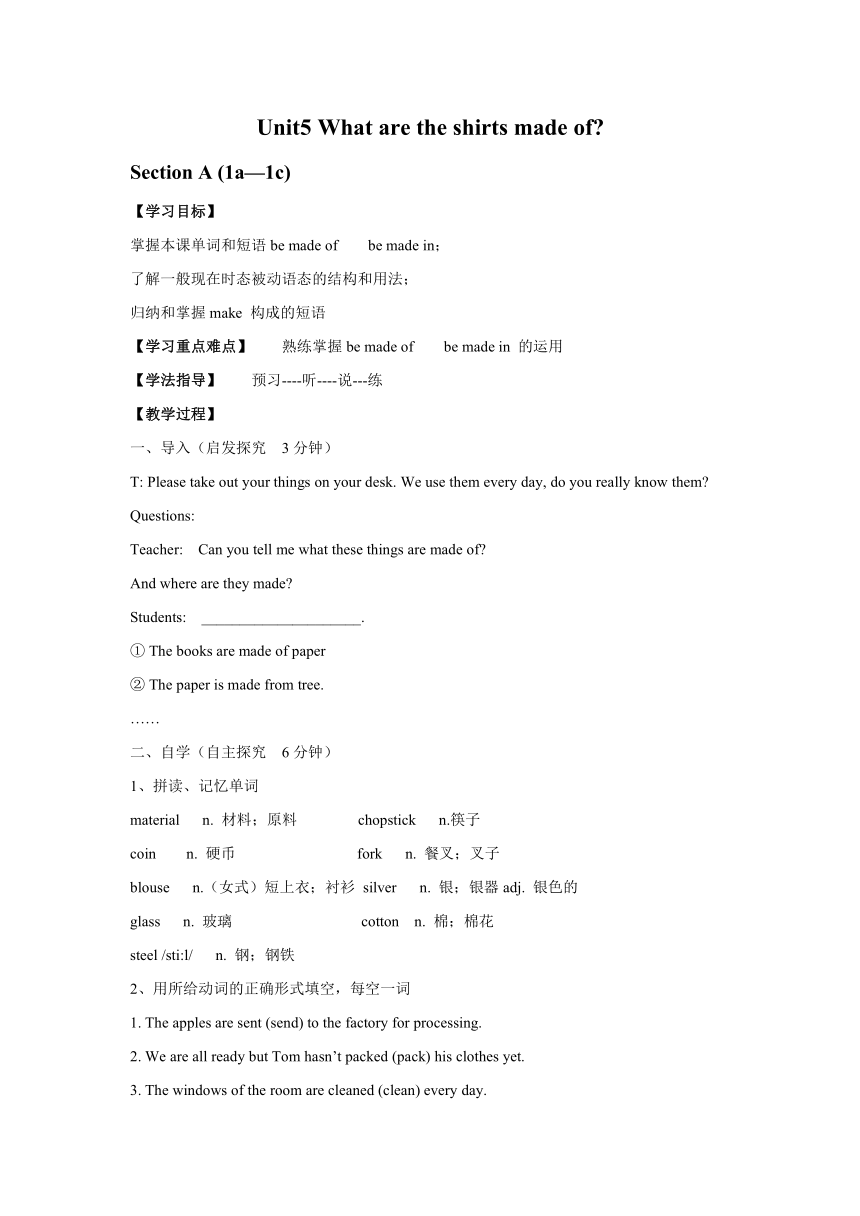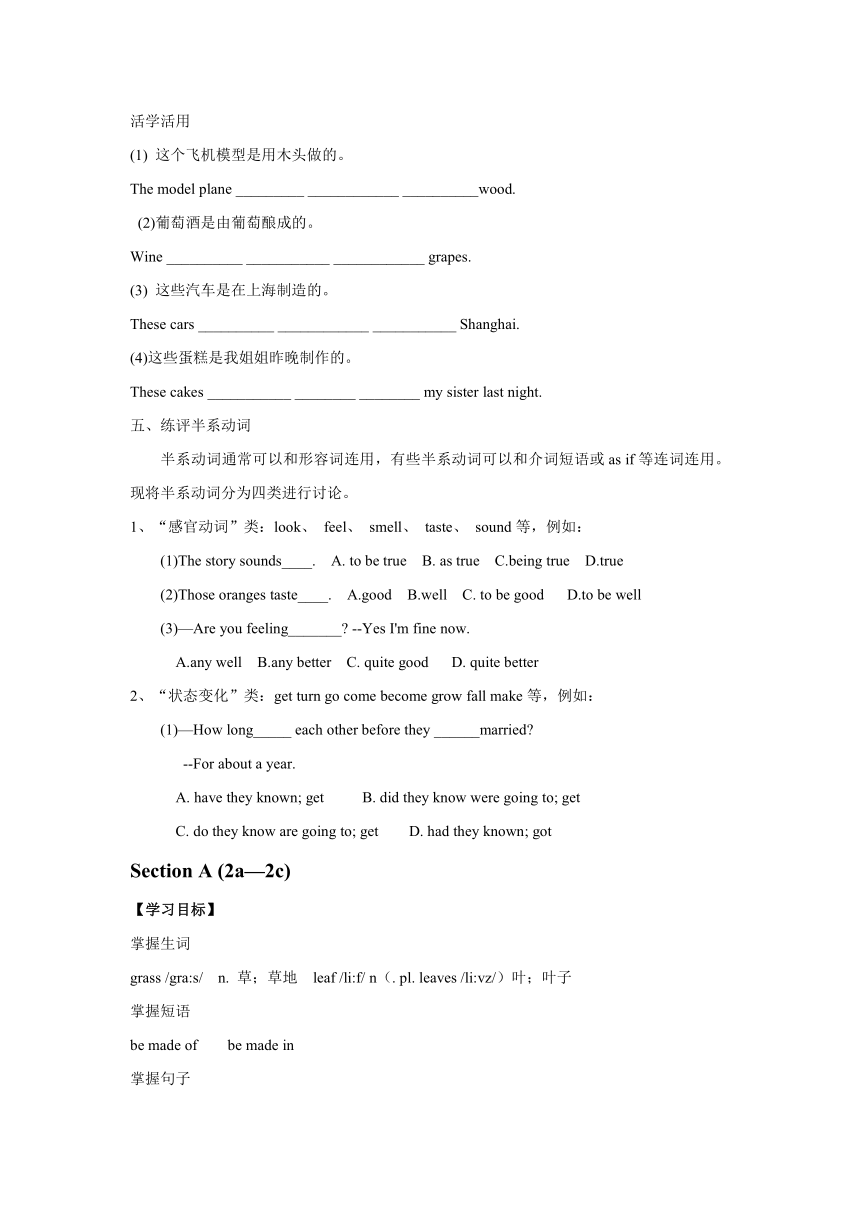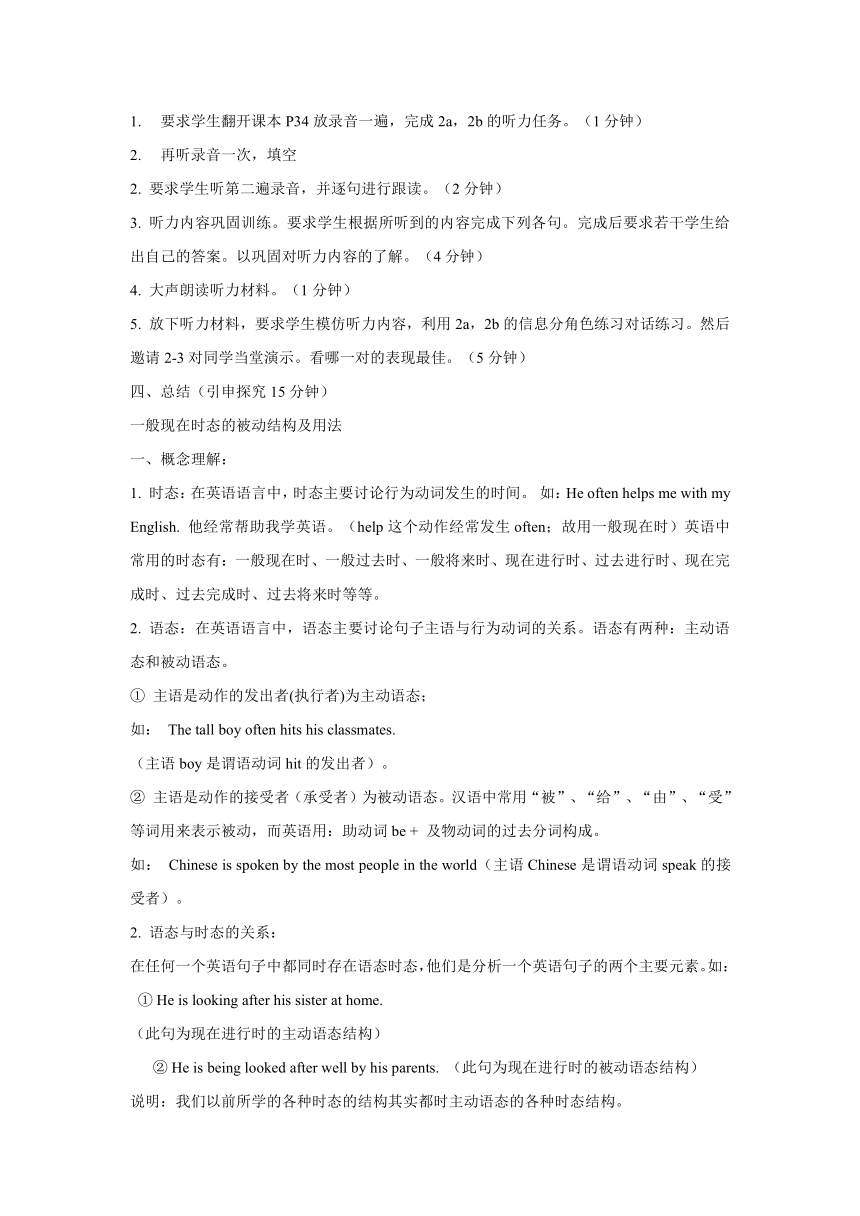Unit 5 What are the shirts made of Section A 教案1
文档属性
| 名称 | Unit 5 What are the shirts made of Section A 教案1 |  | |
| 格式 | zip | ||
| 文件大小 | 20.8KB | ||
| 资源类型 | 教案 | ||
| 版本资源 | 人教新目标(Go for it)版 | ||
| 科目 | 英语 | ||
| 更新时间 | 2016-06-30 16:12:03 | ||
图片预览





文档简介
Unit5
What
are
the
shirts
made
of
Section
A
(1a—1c)
【学习目标】
掌握本课单词和短语be
made
of
be
made
in;
了解一般现在时态被动语态的结构和用法;
归纳和掌握make
构成的短语
【学习重点难点】
熟练掌握be
made
of
be
made
in
的运用
【学法指导】
预习----听----说---练
【教学过程】
一、导入(启发探究
3分钟)
T:
Please
take
out
your
things
on
your
desk.
We
use
them
every
day,
do
you
really
know
them
Questions:
Teacher:
Can
you
tell
me
what
these
things
are
made
of
And
where
are
they
made
Students:
_____________________.
①
The
books
are
made
of
paper
②
The
paper
is
made
from
tree.
……
二、自学(自主探究
6分钟)
1、拼读、记忆单词
material
n.
材料;原料
chopstick
n.筷子
coin
n.
硬币
fork
n.
餐叉;叉子
blouse
n.(女式)短上衣;衬衫
silver
n.
银;银器adj.
银色的
glass
n.
玻璃
cotton
n.
棉;棉花
steel
/sti:l/
n.
钢;钢铁
2、用所给动词的正确形式填空,每空一词
1.
The
apples
are
sent
(send)
to
the
factory
for
processing.
2.
We
are
all
ready
but
Tom
hasn’t
packed
(pack)
his
clothes
yet.
3.
The
windows
of
the
room
are
cleaned
(clean)
every
day.
4.
The
best
cotton
is
produced
(produce)
in
Xing
Jiang
in
China.
5.
The
song
isn’t
liked
(not
like)
by
most
of
us.
3、快速阅读1a表格部分的内容。把物品和可能构成他们的材料匹配起来。(1分钟)
4、核对检查答案,再次朗读、记忆单词。
三、交流(合作探究
10分钟)
1、听录音一次,体会语音语调、句群停顿。(1分钟)
2、听第二遍录音,并完成课本上1b的听力任务。(1分钟)
3、再听录音一次,填空。
4、听第三遍录音,并逐句进行跟读。(2分钟)
5、朗读录音材料,模仿语音语调、句群停顿。(2分钟)
6、两人一组先练习1a中的对话,再模仿1c的对话,用1b表格中的信息进行对话练习。并邀请2-3对同学当堂进行演示。(3分钟)
7、勾画短语并读背、翻译短语。
(1分钟)
四、总结(引申探究
15分钟)
1、made
of.
由…制(构)成。后接构成某物质的原料。
【备课例句】
This
skirt
is
made
of
silk.这件裙子是用丝绸制成的。
【横向辐射】be
made
of/from/up
of的区别
1.
be
made
of
表示制成成品后,仍可看出原材料是什么
保留原材料的质和形状,制作过程仅发生物理变化。
【例句】:The
kite
is
made
of
paper.
风筝是用纸做的。
2.
be
made
from
表示制成的东西完全失去了原材料的外形或特征,或原材料在制作过程中发生化学变化,在成品中已无法辨认。
【例句】The
paper
is
made
from
wood.纸是木头做的。
Butter
is
made
from
milk.黄油是从牛奶中提炼出来的。
3.
be
made
up
of
用…构成或组成的。指人、物皆可,指结构成分。
【例句】Our
class
is
made
up
of
six
groups.
我们班是由六个小组组成的。
4.
be
made
in
+地点
意为“在……(地方)制成”;
5.
be
made
by
意为“被(某人)……制成”。
活学活用
(1)
这个飞机模型是用木头做的。
The
model
plane
_________
____________
__________wood.
(2)葡萄酒是由葡萄酿成的。
Wine
__________
___________
____________
grapes.
(3)
这些汽车是在上海制造的。
These
cars
__________
____________
___________
Shanghai.
(4)这些蛋糕是我姐姐昨晚制作的。
These
cakes
___________
________
________
my
sister
last
night.
五、练评半系动词
半系动词通常可以和形容词连用,有些半系动词可以和介词短语或as
if等连词连用。现将半系动词分为四类进行讨论。
1、“感官动词”类:look、
feel、
smell、
taste、
sound等,例如:
(1)The
story
sounds____.
A.
to
be
true
B.
as
true
C.being
true
D.true
(2)Those
oranges
taste____.
A.good
B.well
C.
to
be
good
D.to
be
well
(3)—Are
you
feeling_______
--Yes
I'm
fine
now.
A.any
well
B.any
better
C.
quite
good
D.
quite
better
2、“状态变化”类:get
turn
go
come
become
grow
fall
make等,例如:
(1)—How
long_____
each
other
before
they
______married
--For
about
a
year.
A.
have
they
known;
get
B.
did
they
know
were
going
to;
get
C.
do
they
know
are
going
to;
get
D.
had
they
known;
got
Section
A
(2a—2c)
【学习目标】
掌握生词
grass
/gra:s/
n.
草;草地
leaf
/li:f/
n(.
pl.
leaves
/li:vz/)叶;叶子
掌握短语
be
made
of
be
made
in
掌握句子
What
is
it
made
of
It’s
made
of
used
wood
and
glass.
Who
is
it
made
by
It’s
made
by
university
students.
掌握一般现在时态被动语态的构成和运用
【学习重点难点】
掌握句子
What
is
it
made
of
It’s
made
of
used
wood
and
glass.
Who
is
it
made
by
It’s
made
by
university
students.
掌握一般现在时态被动语态的构成和运用
【学法指导】
复习---听说---听力训练---作业巩固
【教学过程】
一、导入(启发探究3分钟)
What
is
this
It’s
a
huge
model
plane.
What
is
it
made
of
It’s
made
of
used
wood
and
glass.
Who
is
it
made
by
It’s
made
by
university
students.
What
is
this
It’s
beautiful
painting.
What
is
it
made
from
It’s
made
from
grass,
leaves
and
flowers.
Who
is
it
made
by
It’s
made
by
university
students.
二、自学(自主探究
6分钟)
1、拼读、记忆单词。
hear
about
hear
of
hear
from
sb.
the
art
and
science
fair
艺术和科学展览会
be
invited
to
pay
for
给钱,付款,买单
2、呈现重要句子,学生朗读理解。
It’s
made
of
used
wood
and
glass.
它是由废弃的木头和玻璃做成的
It’s
made
from
grass,
leaves
and
flowers.
它是用草、树叶和花做成的
The
fair
is
about
environmental
protection
and
recycling.
展览会是关于环境保护和回收利用的
come
up
with
提出,想出
some
really
interesting
and
creative
ideas
一些既很有趣又有创意的主意
三、交流(合作探究
10分钟)
1.
要求学生翻开课本P34放录音一遍,完成2a,2b的听力任务。(1分钟)
2.
再听录音一次,填空
2.
要求学生听第二遍录音,并逐句进行跟读。(2分钟)
3.
听力内容巩固训练。要求学生根据所听到的内容完成下列各句。完成后要求若干学生给出自己的答案。以巩固对听力内容的了解。(4分钟)
4.
大声朗读听力材料。(1分钟)
5.
放下听力材料,要求学生模仿听力内容,利用2a,2b的信息分角色练习对话练习。然后邀请2-3对同学当堂演示。看哪一对的表现最佳。(5分钟)
四、总结(引申探究15分钟)
一般现在时态的被动结构及用法
一、概念理解:
1.
时态:在英语语言中,时态主要讨论行为动词发生的时间。
如:He
often
helps
me
with
my
English.
他经常帮助我学英语。(help这个动作经常发生often;故用一般现在时)英语中常用的时态有:一般现在时、一般过去时、一般将来时、现在进行时、过去进行时、现在完成时、过去完成时、过去将来时等等。
2.
语态:在英语语言中,语态主要讨论句子主语与行为动词的关系。语态有两种:主动语态和被动语态。
①
主语是动作的发出者(执行者)为主动语态;
如:
The
tall
boy
often
hits
his
classmates.
(主语boy是谓语动词hit的发出者)。
②
主语是动作的接受者(承受者)为被动语态。汉语中常用“被”、“给”、“由”、“受”等词用来表示被动,而英语用:助动词be
+
及物动词的过去分词构成。
如:
Chinese
is
spoken
by
the
most
people
in
the
world(主语Chinese是谓语动词speak的接受者)。
2.
语态与时态的关系:
在任何一个英语句子中都同时存在语态时态,他们是分析一个英语句子的两个主要元素。如:
①
He
is
looking
after
his
sister
at
home.
(此句为现在进行时的主动语态结构)
②
He
is
being
looked
after
well
by
his
parents.
(此句为现在进行时的被动语态结构)
说明:我们以前所学的各种时态的结构其实都时主动语态的各种时态结构。
二、被动语态最基本的句型结构是:
be
+及物动词过去分词
说明:①、be
有时态,人称和数的变化。
②、被动语态中的谓语动词必须是及物动词;因为被动句中的主语是动作的承受者,某些短语动词如look
after,
think
of,
take
care
of,
work
out,
laugh
at等,也可用于被动语态。
三、被动语态的使用
1.当不知道或没有必要指出动作的执行者时,常用被动语态,这时往往不用by
短语。
“Mr.
White,
the
cup
with
mixture
was
broken
after
class.
”(只是告诉老师杯子坏了,不知是谁弄坏的,或不想说出谁弄坏的)。
2.突出或强调动作的承受者,如果需要说出动作的执行者,用by
短语。如:The
cup
was
broken
by
Paul.
3.当汉语句子的主语既不是动作的执行者,也不是动作的承受者时,这时常用in
+
名词作状语,而代替
by
短语。
如:These
cars
were
made
in
China.
四、主动语态变被动语态的变法:
主动语态与被动语态之间如何转换
1.把主动语态的宾语变成被动语态的主语。
2.把主动语态的谓语变成被动语态的be
+
过去分词,时态要与原句保持一致。
3.把主动语态的主语变为介词by
的宾语,放在被动语态里谓语动词之后,by短语可以省略。如果原句主语是地点名词,在被动语态中用in
+
地点名词作状语。
口诀:宾变主,主变宾,谓变be
done,时不变,数格必须随被变。
五、一般现在时的被动语态:am
/is/
are
+done
如:
Tea
is
grown
in
Hangzhou.
杭州种植茶叶。
五、练评
Section
A
(4a—4c)
【学习目标】
单词:
1.Germany
德国;(形容词)German
2.
surface
n.
表面,表层;
3.
material
n
材料,原料;
4.
traffic
n.
交通;
短语:
1.
on
the
last
Friday
of
each
month
在每月的最后一个星期五
2.
in
Germany
在德国
3.
most
of
the
earth’s
surface地球的大部分表面
4.
cause
many
traffic
accidents
导致许多的交通事故
5.
use
this
silver
plate
使用这个银制的盘子
【学习重点难点】继续学习使用一般现在时态的被动语态进行连词成句的练习
【学法指导】复习语法---朗读语法句子---连词成句—对话---巩固
【教学过程】
一、导入(启发探究3分钟)
一般现在时的被动语态
语态是动词的一种形式,表示句子中主语和谓语动词的关系。主动语态表示主语是动作的执行者;被动语态表示主语是动作的承受者。只有及物动词才能用于被动语态。
如果是不用物动词,其过去分词应带有相应的介词。例如:
许多人都踢足球。Many
people
play
football.
~Football
is
played
by
many
people.
一、被动语态的构成
由“助动词be+及物动词的过去分词”构成,助动词be
有人称、数和时态的变化,其变化规则与be
作为连系动词时完全一样。如果需要强调动作或行为的执行者时,在其后接“by...”,意为“被…”
主动语态变被动语态的方法
1.将主动语态的宾语作被动语态的主语
2.谓语动词变为“be+过去分词”,并通过be的变化来表达出不同的时态
3.主动语态的主语变为介词by的宾语,组成介词短语放在被动结构中的谓语动词之后。(有时by短语可省略)
为取胜更清晰、更深刻地理解被动语态的含义,可以将主动语态和被动语态的句子结构进行比较。
主动语态:
主语+
谓语动词
+
宾语
+
其他成分
被动语态:
主语+
be
+过去分词
+
by
+宾语
+其他成分
如:
Many
people
speak
English.
被动语态
English
is
spoken
by
many
people.
被动语态中by短语的省略
被动语态中的“by+宾语”表示及物动词所表示动作的执行者。但是在遇到以下情况时,表示动作执行者的by短语常常被省略。
1.动作执行者不确定时
Many
people
are
killed
in
traffic
accidents
every
year.
2.不必表明动作执行者时
These
trees
were
planted
last
year.
3.动作执行者为一般大众时
Both
English
and
Spanish
are
spoken
in
this
area.
4.下面这些动词短语本身已经是被动形式,不需要再加by短语
be
interested
in对…感兴趣
be
made
of/from由…制成
be
covered
with用…覆盖
be
surprised
at
对…感到惊奇
被动语态的基本用法
需要强调动作的承受者时
Water
is
needed
very
much
by
the
crops
here.
不知道或没必要指出动作的执行者时
Sandy
was
invited
to
a
party
after
school.
当说话人需要强调客观时
It
is
said
that
the
temperature
tomorrow
will
be
fine.
二、自学(自主探究
6分钟)
1、拼读记忆单词
Germany
德国
surface
n.
表面;表层
postman
n.
邮递员
cap
n(.
尤指有帽舌的)帽子
glove
n(.
分手指的)手套
2、根据汉语提示完成单词。
1.
Toney
has
to
drive
to
meet
his
boss
(老板)
at
the
airport
this
afternoon.
2.
His
father
built
a
new
house
with
different
used
material
(材料)
beside
the
river.
3.
This
kind
of
car
is
very
expensive
and
only
made
in
Germany
(德国)by
hand.
3、呈现短语,朗读并背诵短语:
1.
on
the
last
Friday
of
each
month
在每月的最后一个星期五
2.
in
Germany
在德国
3.
most
of
the
earth’s
surface地球的大部分表面
4.
cause
many
traffic
accidents
导致许多的交通事故
5.
use
this
silver
plate
使用这个银制的盘子
4、朗读一般现在时态的被动语态的句子,体会和揣摩其结构和运用。
1.
---Are
your
shirts
made
of
cotton
--Yes,
they
are.
And
they
were
made
in
the
US.
---你的衬衣是由棉花制成的吗?
---是的。并且是在美国制造的。
2.
---What’s
the
model
plane
made
of
---It’s
made
of
used
wood
and
glass.
---这个飞机模型是由什么制成的?
---它是由废弃的木材和玻璃制成的。.
3.
---Where
was
your
pencil
made
---It
was
made
in
Shanghai.
---你的铅笔是在哪制造的?
---它是在上海制造的。
4.
---What
language
is
spoken
in
Germany
---Most
people
speak
German,
but
many
can
speak
English.
---在德国讲什么语言?
---大部分人讲德语,但许多人也讲英语。
三、交流(合作探究
10分钟)
畅通Grammar
Focus回顾语法重点。
要求学生分角色问答并翻译表格中的句子。出说被动语态的各种句式的变化形式。并能造出相仿的句子。简要归纳被动语态的结构及用法
四、总结(引申探究
15分钟)
双宾语,很奇特,被动语态有两个,用人简单用物难,难在人前to,for添常见的接双宾语的动词有:
to:
(1)pass
sb.
sth=pass
sth
to
sb
(2)
give
sb
sth=
give
sth.
to
sb
(3)teach
sb
sth=teach
sth
to
sb
(4)show
sb
sth=show
sth
to
sb
(5)
bring
sb
sth=bring
sth
to
sb
(6)send
sb
sth=send
sth
to
sb
(7)hand
sb
sth
=hand
sth
to
sb
(8)
sell
sb
sth=sell
sth
to
sb
(9)
take
sb
sth
=take
sth
to
sb
(10)
write
sb
sth=write
sth
to
sb
for:
(1)
make
sb
sth=
make
sth
for
sb
(2)
buy
sb
sth
=buy
sth
for
sb
(3)
get
sb
sth=
get
sth
for
sb
(4)
cook
sb
sth
=cook
sth
for
sb
(5)
keep
ab
sth=keep
sth
for
sb
(6)
sing
sb
sth=sing
sth
for
sb
(7)
find
sb
sth=find
sth
for
sb
(8)
mend
sb
sth=mend
sth
for
sb
(9)perform
sb
sth=perform
sth
for
sb
既可用for也可用to的词:read
【作业】
完成课后练习。
What
are
the
shirts
made
of
Section
A
(1a—1c)
【学习目标】
掌握本课单词和短语be
made
of
be
made
in;
了解一般现在时态被动语态的结构和用法;
归纳和掌握make
构成的短语
【学习重点难点】
熟练掌握be
made
of
be
made
in
的运用
【学法指导】
预习----听----说---练
【教学过程】
一、导入(启发探究
3分钟)
T:
Please
take
out
your
things
on
your
desk.
We
use
them
every
day,
do
you
really
know
them
Questions:
Teacher:
Can
you
tell
me
what
these
things
are
made
of
And
where
are
they
made
Students:
_____________________.
①
The
books
are
made
of
paper
②
The
paper
is
made
from
tree.
……
二、自学(自主探究
6分钟)
1、拼读、记忆单词
material
n.
材料;原料
chopstick
n.筷子
coin
n.
硬币
fork
n.
餐叉;叉子
blouse
n.(女式)短上衣;衬衫
silver
n.
银;银器adj.
银色的
glass
n.
玻璃
cotton
n.
棉;棉花
steel
/sti:l/
n.
钢;钢铁
2、用所给动词的正确形式填空,每空一词
1.
The
apples
are
sent
(send)
to
the
factory
for
processing.
2.
We
are
all
ready
but
Tom
hasn’t
packed
(pack)
his
clothes
yet.
3.
The
windows
of
the
room
are
cleaned
(clean)
every
day.
4.
The
best
cotton
is
produced
(produce)
in
Jiang
in
China.
5.
The
song
isn’t
liked
(not
like)
by
most
of
us.
3、快速阅读1a表格部分的内容。把物品和可能构成他们的材料匹配起来。(1分钟)
4、核对检查答案,再次朗读、记忆单词。
三、交流(合作探究
10分钟)
1、听录音一次,体会语音语调、句群停顿。(1分钟)
2、听第二遍录音,并完成课本上1b的听力任务。(1分钟)
3、再听录音一次,填空。
4、听第三遍录音,并逐句进行跟读。(2分钟)
5、朗读录音材料,模仿语音语调、句群停顿。(2分钟)
6、两人一组先练习1a中的对话,再模仿1c的对话,用1b表格中的信息进行对话练习。并邀请2-3对同学当堂进行演示。(3分钟)
7、勾画短语并读背、翻译短语。
(1分钟)
四、总结(引申探究
15分钟)
1、made
of.
由…制(构)成。后接构成某物质的原料。
【备课例句】
This
skirt
is
made
of
silk.这件裙子是用丝绸制成的。
【横向辐射】be
made
of/from/up
of的区别
1.
be
made
of
表示制成成品后,仍可看出原材料是什么
保留原材料的质和形状,制作过程仅发生物理变化。
【例句】:The
kite
is
made
of
paper.
风筝是用纸做的。
2.
be
made
from
表示制成的东西完全失去了原材料的外形或特征,或原材料在制作过程中发生化学变化,在成品中已无法辨认。
【例句】The
paper
is
made
from
wood.纸是木头做的。
Butter
is
made
from
milk.黄油是从牛奶中提炼出来的。
3.
be
made
up
of
用…构成或组成的。指人、物皆可,指结构成分。
【例句】Our
class
is
made
up
of
six
groups.
我们班是由六个小组组成的。
4.
be
made
in
+地点
意为“在……(地方)制成”;
5.
be
made
by
意为“被(某人)……制成”。
活学活用
(1)
这个飞机模型是用木头做的。
The
model
plane
_________
____________
__________wood.
(2)葡萄酒是由葡萄酿成的。
Wine
__________
___________
____________
grapes.
(3)
这些汽车是在上海制造的。
These
cars
__________
____________
___________
Shanghai.
(4)这些蛋糕是我姐姐昨晚制作的。
These
cakes
___________
________
________
my
sister
last
night.
五、练评半系动词
半系动词通常可以和形容词连用,有些半系动词可以和介词短语或as
if等连词连用。现将半系动词分为四类进行讨论。
1、“感官动词”类:look、
feel、
smell、
taste、
sound等,例如:
(1)The
story
sounds____.
A.
to
be
true
B.
as
true
C.being
true
D.true
(2)Those
oranges
taste____.
A.good
B.well
C.
to
be
good
D.to
be
well
(3)—Are
you
feeling_______
--Yes
I'm
fine
now.
A.any
well
B.any
better
C.
quite
good
D.
quite
better
2、“状态变化”类:get
turn
go
come
become
grow
fall
make等,例如:
(1)—How
long_____
each
other
before
they
______married
--For
about
a
year.
A.
have
they
known;
get
B.
did
they
know
were
going
to;
get
C.
do
they
know
are
going
to;
get
D.
had
they
known;
got
Section
A
(2a—2c)
【学习目标】
掌握生词
grass
/gra:s/
n.
草;草地
leaf
/li:f/
n(.
pl.
leaves
/li:vz/)叶;叶子
掌握短语
be
made
of
be
made
in
掌握句子
What
is
it
made
of
It’s
made
of
used
wood
and
glass.
Who
is
it
made
by
It’s
made
by
university
students.
掌握一般现在时态被动语态的构成和运用
【学习重点难点】
掌握句子
What
is
it
made
of
It’s
made
of
used
wood
and
glass.
Who
is
it
made
by
It’s
made
by
university
students.
掌握一般现在时态被动语态的构成和运用
【学法指导】
复习---听说---听力训练---作业巩固
【教学过程】
一、导入(启发探究3分钟)
What
is
this
It’s
a
huge
model
plane.
What
is
it
made
of
It’s
made
of
used
wood
and
glass.
Who
is
it
made
by
It’s
made
by
university
students.
What
is
this
It’s
beautiful
painting.
What
is
it
made
from
It’s
made
from
grass,
leaves
and
flowers.
Who
is
it
made
by
It’s
made
by
university
students.
二、自学(自主探究
6分钟)
1、拼读、记忆单词。
hear
about
hear
of
hear
from
sb.
the
art
and
science
fair
艺术和科学展览会
be
invited
to
pay
for
给钱,付款,买单
2、呈现重要句子,学生朗读理解。
It’s
made
of
used
wood
and
glass.
它是由废弃的木头和玻璃做成的
It’s
made
from
grass,
leaves
and
flowers.
它是用草、树叶和花做成的
The
fair
is
about
environmental
protection
and
recycling.
展览会是关于环境保护和回收利用的
come
up
with
提出,想出
some
really
interesting
and
creative
ideas
一些既很有趣又有创意的主意
三、交流(合作探究
10分钟)
1.
要求学生翻开课本P34放录音一遍,完成2a,2b的听力任务。(1分钟)
2.
再听录音一次,填空
2.
要求学生听第二遍录音,并逐句进行跟读。(2分钟)
3.
听力内容巩固训练。要求学生根据所听到的内容完成下列各句。完成后要求若干学生给出自己的答案。以巩固对听力内容的了解。(4分钟)
4.
大声朗读听力材料。(1分钟)
5.
放下听力材料,要求学生模仿听力内容,利用2a,2b的信息分角色练习对话练习。然后邀请2-3对同学当堂演示。看哪一对的表现最佳。(5分钟)
四、总结(引申探究15分钟)
一般现在时态的被动结构及用法
一、概念理解:
1.
时态:在英语语言中,时态主要讨论行为动词发生的时间。
如:He
often
helps
me
with
my
English.
他经常帮助我学英语。(help这个动作经常发生often;故用一般现在时)英语中常用的时态有:一般现在时、一般过去时、一般将来时、现在进行时、过去进行时、现在完成时、过去完成时、过去将来时等等。
2.
语态:在英语语言中,语态主要讨论句子主语与行为动词的关系。语态有两种:主动语态和被动语态。
①
主语是动作的发出者(执行者)为主动语态;
如:
The
tall
boy
often
hits
his
classmates.
(主语boy是谓语动词hit的发出者)。
②
主语是动作的接受者(承受者)为被动语态。汉语中常用“被”、“给”、“由”、“受”等词用来表示被动,而英语用:助动词be
+
及物动词的过去分词构成。
如:
Chinese
is
spoken
by
the
most
people
in
the
world(主语Chinese是谓语动词speak的接受者)。
2.
语态与时态的关系:
在任何一个英语句子中都同时存在语态时态,他们是分析一个英语句子的两个主要元素。如:
①
He
is
looking
after
his
sister
at
home.
(此句为现在进行时的主动语态结构)
②
He
is
being
looked
after
well
by
his
parents.
(此句为现在进行时的被动语态结构)
说明:我们以前所学的各种时态的结构其实都时主动语态的各种时态结构。
二、被动语态最基本的句型结构是:
be
+及物动词过去分词
说明:①、be
有时态,人称和数的变化。
②、被动语态中的谓语动词必须是及物动词;因为被动句中的主语是动作的承受者,某些短语动词如look
after,
think
of,
take
care
of,
work
out,
laugh
at等,也可用于被动语态。
三、被动语态的使用
1.当不知道或没有必要指出动作的执行者时,常用被动语态,这时往往不用by
短语。
“Mr.
White,
the
cup
with
mixture
was
broken
after
class.
”(只是告诉老师杯子坏了,不知是谁弄坏的,或不想说出谁弄坏的)。
2.突出或强调动作的承受者,如果需要说出动作的执行者,用by
短语。如:The
cup
was
broken
by
Paul.
3.当汉语句子的主语既不是动作的执行者,也不是动作的承受者时,这时常用in
+
名词作状语,而代替
by
短语。
如:These
cars
were
made
in
China.
四、主动语态变被动语态的变法:
主动语态与被动语态之间如何转换
1.把主动语态的宾语变成被动语态的主语。
2.把主动语态的谓语变成被动语态的be
+
过去分词,时态要与原句保持一致。
3.把主动语态的主语变为介词by
的宾语,放在被动语态里谓语动词之后,by短语可以省略。如果原句主语是地点名词,在被动语态中用in
+
地点名词作状语。
口诀:宾变主,主变宾,谓变be
done,时不变,数格必须随被变。
五、一般现在时的被动语态:am
/is/
are
+done
如:
Tea
is
grown
in
Hangzhou.
杭州种植茶叶。
五、练评
Section
A
(4a—4c)
【学习目标】
单词:
1.Germany
德国;(形容词)German
2.
surface
n.
表面,表层;
3.
material
n
材料,原料;
4.
traffic
n.
交通;
短语:
1.
on
the
last
Friday
of
each
month
在每月的最后一个星期五
2.
in
Germany
在德国
3.
most
of
the
earth’s
surface地球的大部分表面
4.
cause
many
traffic
accidents
导致许多的交通事故
5.
use
this
silver
plate
使用这个银制的盘子
【学习重点难点】继续学习使用一般现在时态的被动语态进行连词成句的练习
【学法指导】复习语法---朗读语法句子---连词成句—对话---巩固
【教学过程】
一、导入(启发探究3分钟)
一般现在时的被动语态
语态是动词的一种形式,表示句子中主语和谓语动词的关系。主动语态表示主语是动作的执行者;被动语态表示主语是动作的承受者。只有及物动词才能用于被动语态。
如果是不用物动词,其过去分词应带有相应的介词。例如:
许多人都踢足球。Many
people
play
football.
~Football
is
played
by
many
people.
一、被动语态的构成
由“助动词be+及物动词的过去分词”构成,助动词be
有人称、数和时态的变化,其变化规则与be
作为连系动词时完全一样。如果需要强调动作或行为的执行者时,在其后接“by...”,意为“被…”
主动语态变被动语态的方法
1.将主动语态的宾语作被动语态的主语
2.谓语动词变为“be+过去分词”,并通过be的变化来表达出不同的时态
3.主动语态的主语变为介词by的宾语,组成介词短语放在被动结构中的谓语动词之后。(有时by短语可省略)
为取胜更清晰、更深刻地理解被动语态的含义,可以将主动语态和被动语态的句子结构进行比较。
主动语态:
主语+
谓语动词
+
宾语
+
其他成分
被动语态:
主语+
be
+过去分词
+
by
+宾语
+其他成分
如:
Many
people
speak
English.
被动语态
English
is
spoken
by
many
people.
被动语态中by短语的省略
被动语态中的“by+宾语”表示及物动词所表示动作的执行者。但是在遇到以下情况时,表示动作执行者的by短语常常被省略。
1.动作执行者不确定时
Many
people
are
killed
in
traffic
accidents
every
year.
2.不必表明动作执行者时
These
trees
were
planted
last
year.
3.动作执行者为一般大众时
Both
English
and
Spanish
are
spoken
in
this
area.
4.下面这些动词短语本身已经是被动形式,不需要再加by短语
be
interested
in对…感兴趣
be
made
of/from由…制成
be
covered
with用…覆盖
be
surprised
at
对…感到惊奇
被动语态的基本用法
需要强调动作的承受者时
Water
is
needed
very
much
by
the
crops
here.
不知道或没必要指出动作的执行者时
Sandy
was
invited
to
a
party
after
school.
当说话人需要强调客观时
It
is
said
that
the
temperature
tomorrow
will
be
fine.
二、自学(自主探究
6分钟)
1、拼读记忆单词
Germany
德国
surface
n.
表面;表层
postman
n.
邮递员
cap
n(.
尤指有帽舌的)帽子
glove
n(.
分手指的)手套
2、根据汉语提示完成单词。
1.
Toney
has
to
drive
to
meet
his
boss
(老板)
at
the
airport
this
afternoon.
2.
His
father
built
a
new
house
with
different
used
material
(材料)
beside
the
river.
3.
This
kind
of
car
is
very
expensive
and
only
made
in
Germany
(德国)by
hand.
3、呈现短语,朗读并背诵短语:
1.
on
the
last
Friday
of
each
month
在每月的最后一个星期五
2.
in
Germany
在德国
3.
most
of
the
earth’s
surface地球的大部分表面
4.
cause
many
traffic
accidents
导致许多的交通事故
5.
use
this
silver
plate
使用这个银制的盘子
4、朗读一般现在时态的被动语态的句子,体会和揣摩其结构和运用。
1.
---Are
your
shirts
made
of
cotton
--Yes,
they
are.
And
they
were
made
in
the
US.
---你的衬衣是由棉花制成的吗?
---是的。并且是在美国制造的。
2.
---What’s
the
model
plane
made
of
---It’s
made
of
used
wood
and
glass.
---这个飞机模型是由什么制成的?
---它是由废弃的木材和玻璃制成的。.
3.
---Where
was
your
pencil
made
---It
was
made
in
Shanghai.
---你的铅笔是在哪制造的?
---它是在上海制造的。
4.
---What
language
is
spoken
in
Germany
---Most
people
speak
German,
but
many
can
speak
English.
---在德国讲什么语言?
---大部分人讲德语,但许多人也讲英语。
三、交流(合作探究
10分钟)
畅通Grammar
Focus回顾语法重点。
要求学生分角色问答并翻译表格中的句子。出说被动语态的各种句式的变化形式。并能造出相仿的句子。简要归纳被动语态的结构及用法
四、总结(引申探究
15分钟)
双宾语,很奇特,被动语态有两个,用人简单用物难,难在人前to,for添常见的接双宾语的动词有:
to:
(1)pass
sb.
sth=pass
sth
to
sb
(2)
give
sb
sth=
give
sth.
to
sb
(3)teach
sb
sth=teach
sth
to
sb
(4)show
sb
sth=show
sth
to
sb
(5)
bring
sb
sth=bring
sth
to
sb
(6)send
sb
sth=send
sth
to
sb
(7)hand
sb
sth
=hand
sth
to
sb
(8)
sell
sb
sth=sell
sth
to
sb
(9)
take
sb
sth
=take
sth
to
sb
(10)
write
sb
sth=write
sth
to
sb
for:
(1)
make
sb
sth=
make
sth
for
sb
(2)
buy
sb
sth
=buy
sth
for
sb
(3)
get
sb
sth=
get
sth
for
sb
(4)
cook
sb
sth
=cook
sth
for
sb
(5)
keep
ab
sth=keep
sth
for
sb
(6)
sing
sb
sth=sing
sth
for
sb
(7)
find
sb
sth=find
sth
for
sb
(8)
mend
sb
sth=mend
sth
for
sb
(9)perform
sb
sth=perform
sth
for
sb
既可用for也可用to的词:read
【作业】
完成课后练习。
同课章节目录
- Unit 1 How can we become good learners.
- Section A
- Section B
- Unit 2 I think that mooncakes are delicious!
- Section A
- Section B
- Unit 3 Could you please tell me where the restroom
- Section A
- Section B
- Unit 4 I used to be afraid of the dark.
- Section A
- Section B
- Unit 5 What are the shirts made of?
- Section A
- Section B
- Review of Units 1-5
- Unit 6 When was it invented?
- Section A
- Section B
- Unit 7 Teenagers should be allowed to choose their
- Section A
- Section B
- Unit 8 It must belong to Carla.
- Section A
- Section B
- Unit 9 I like music that I can dance to.
- Section A
- Section B
- Unit 10 You're supposed to shake hands.
- Section A
- Section B
- Review of Units 6-10
- Unit 11 Sad movies make me cry.
- Section A
- Section B
- Unit 12 Life is full of the unexpected
- Section A
- Section B
- Unit 13 We're trying to save the earth!
- Section A
- Section B
- Unit 14 I remember meeting all of you in Grade 7.
- Section A
- Section B
- Review of Units 11-14
